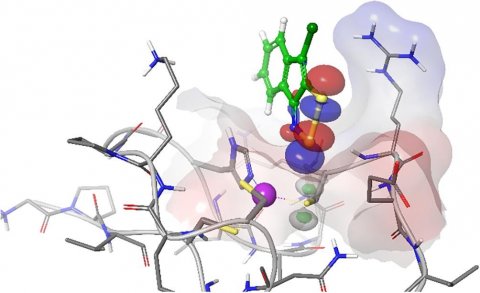Researchers from South Ural State University and the N.D. Zelinsky Institute of Organic Chemistry, Russian Academy of Sciences are studying polysulphur-nitrogen heterocycles – organic compounds which have antiviral properties and can be applied for the treatment of AIDS. Other universities involved in this collaboration include the University of Zurich (Switzerland), University College London (Great Britain), the University of North Carolina (USA), and the University of Eastern Finland (Finland). One of the most recent articles dedicated to this research was published in Bioorganic & Medicinal Chemistry Letters (Q1).
Original heterocycles deactivate viruses
Acquired immunodeficiency syndrome (AIDS) is a serious illness that results from the human immunodeficiency viruses (HIV). For now, AIDS is an incurable desease; the virus can not be totally destroyed by any currently-known methods, but researchers from all over the world are working to create medicines that can help patients dealing with this illness.
In 2015, South Ural State University and the N.D. Zelinsky Institute of Organic Chemistry established a laboratory for synthesis of original polysulphur-nitrogen heterocycles and searching for new compounds with high and varied biological activity.
“From the very beginning, we believed the most promising area of research to be the anti-cancer activity of this compound class. However, unexpectedly, it became clear to us that this kind of compound can also have high and selective activity against the feline immunodeficiency virus, which is the closest analog to HIV,” says Professor Oleg Rakitin, Doctor of Sciences (Chemistry).
The researchers have determined that various heterocyclic structures are promising compounds for fighting AIDS, which is of significant value for the development of both chemistry and biology.
“The main research result of our studies was the discovery of the general mechanism of action of the polysulphur-nitrogen hetrocycles that we synthesized: polysulphur-nitrogen heterocycles with a sulfur-sulfur (or sulfur-selenium) bond can open up within the body with the formation of dithiols, which interact with zinc atoms by almost ‘drawing them out’ of the viral molecules as protein-zinc-thiol complexes, thereby deactivating them,” explains Oleg Rakitin.
It is worth noting that this mechanism of action in antiviral medications has not been observed before. During their research, medications were found among the studied compounds which have both high antiviral activity and low toxicity for typical cells. The discovery of this mechanism allowed the researchers to open up a new class of heterocylic polysulphur-nitrogen compounds that can be utilized as anti-virus medications, as well as the possibility to apply these medications for various viral illnesses with a similar mechanism of action.
.jpg)
Image: Structures of synthesized heterocyclic structures possessing high activity against AIDS
International partnerships to achieve the best results
Characteristic feature of this research is in the high level of collaboration, within which the best groups in the world working in different fields of science got to work together. The synthesis and proof of the construction of new compounds was completed in the joint laboratory between SUSU and IOC RAS, the study of their activity against feline immunodeficiency – at the University of Zurich (Switzerland), research on the mechanism of action of heterocyclic structures – at University College London (Great Britain) and the University of North Carolina (USA), and computer modeling of the biological action of our compounds was completed at the University of Western Finland (Finland).
.jpg)
Photo: Staff of the SUSU and N.D. Zelinsky Institute of Organic Chemistry Laboratory of Polysulphur-Nitrogen Heterocyles.
“Recently, our consortium was joined by a group of researchers from the National Institute of Infectious Diseases (Rio de Janeiro, Brazil), which studies medicines against the Sporotrichosis infection, which is especially wide-spread in Brazil. It is worth noting that every group uses the newest methods in their research, which allows them to achieve strong results which are reflected in many publications in prestigious journals,” stresses Oleg Rakitin.
The results of this research have been presented to the scientific community at a number of prestigious conferences, including the conference of the American Chemical Society.
At this time, the researchers are searching for the optimal structures (with the highest value on the therapeutic index) for each illness type. The importance of the obtained results is that any given medication can be used for different types of illnesses (cancer, HIV, and more), which makes their development more interesting in a practical sense. Research on the mechanism of previously-synthesized compounds will be continued to treat other illnesses with similar mechanisms of action.




